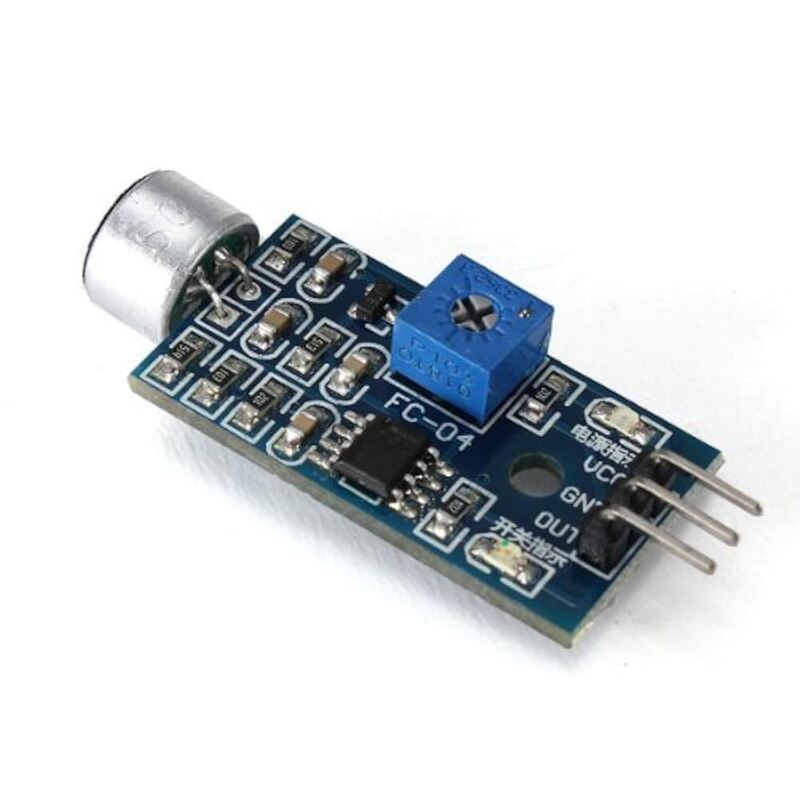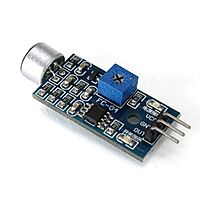


LM393 Sound Sensor
- Features a high-sensitivity electret condenser microphone to capture sound waves
- Utilizes the LM393 voltage comparator chip to provide a distinct digital output
- Offers adjustable sensitivity via an onboard potentiometer to set the detection threshold
- Provides Dual Output: a digital switch (D0) and a raw analog signal (A0)
- Ideal for sound-activated switches, clap-lights, and simple noise detection alarms
- Compatible with microcontrollers like Arduino and Raspberry Pi
Product Details
LM393 Sound Detection Sensor Module (Adjustable Digital Output)
The LM393 Sound Detection Sensor Module is a highly popular and affordable solution for integrating basic acoustic triggering into microcontroller projects. Designed to detect sound intensity that exceeds a user-defined threshold, this module is perfect for creating simple, reactive sound-activated systems.
The module is built around an electret condenser microphone and the LM393 voltage comparator IC. The microphone converts sound waves into an analog voltage signal, which the comparator then processes. This architecture allows the module to function as a simple switch, reporting only whether sound is present or absent above a set noise level, making it easy to interface with digital inputs on microcontrollers like Arduino and Raspberry Pi.
🔧 Key Features and Functionality
- Core Chip: Integrates the reliable LM393 Comparator IC for stable switching behavior.
- Sensitivity Control: Features an onboard potentiometer (trimmer pot) which allows the user to precisely set the sound level threshold (sensitivity) for the digital output.
- Dual Output: Provides both a Digital Output (D0), which goes LOW when the threshold is reached, and a raw Analog Output (A0) for measuring approximate sound amplitude.
- Indicator LED: Includes a signal indication LED that illuminates when the sound detection threshold is crossed, providing immediate visual feedback.
- Wide Compatibility: Designed for use with operating voltages between $3.3V and 5 V DC, ensuring compatibility with most modern microcontroller development boards.
- Purpose: Note that this sensor is a sound level detector, not a sound measurement device. It cannot differentiate between different volumes (decibel levels) or specific frequencies; it only detects an event trigger.
💡 Typical Applications
- Sound-Activated Switches: Turning lights or devices ON/OFF with a clap or shout.
- Simple Alarm Systems: Triggering an alarm when a loud noise is detected.
- Interactive Toys & Robotics: Enabling robots or toys to respond to auditory cues.
- Educational Projects: Learning about comparators, analog-to-digital conversion, and noise detection.
⚙️ Technical Specifications
| Main Chip | LM393 Comparator |
| Microphone Type | Electret Condenser |
| Operating Voltage | $3.3V -5 V DC |
| Output Signal | Digital (D0) and Analog (A0) |
| Digital Output Logic | Low when sound detected |
| Sensitivity | Adjustable via Potentiometer |
| Frequency Range (Mic) | 16 kHz - 20 kHz |
| Dimensions (L x W x H) | approx 3.75 cm x 1.7 cm x1.0 cm |
Specifications
- TypeSOUND SENSOR
- Operating Voltage3.3V – 5V
- Temperature Range−10∘C-45∘C
- Output TypeAnalog and Digital
- Sampling RateInstantaneous
- InterfaceVCC









